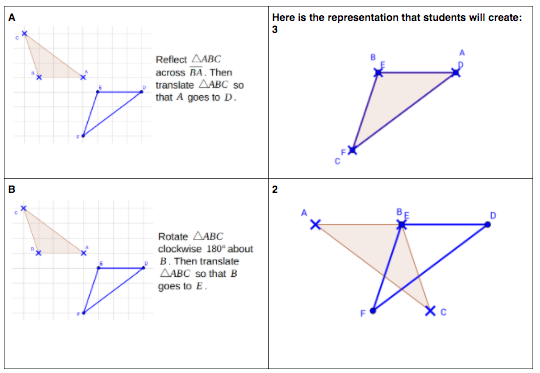Evidence of Understanding
- justify the minimum requirements that show two triangles are congruent
-
describe how a sequence of transformations demonstrates the mapping of corresponding sides for two congruent figures
- use notations to signify the corresponding parts
-
make conjectures about the minimum corresponding parts of the triangle needed to construct a congruent triangle
- experiment with constructions to support these claims
- give examples, non examples, or counterexamples about these claims
- use transformations of these parts to support their claim that the triangles are congruent
-
justify that when all corresponding sides of two triangles are congruent (SSS) there is sufficient evidence to show that these two triangles are congruent
- use tools to construct a copy of a given triangle using side measurements
-
justify that when two corresponding sides and the included angle are congruent (SAS) there is sufficient evidence to show that these two triangles are congruent
- use tools to construct a copy of a given triangle using two side measurements and the included angle
- establish the the minimum criteria necessary to prove two right triangles are congruent using the hypotenuse and a leg (HL)
-
justify that when two corresponding angles and the included side of two triangles are congruent (ASA) there is sufficient evidence to show that these two triangles are congruent
- use tools to construct a copy of a given triangle using two angle measurements and the included side
- justify why the angle has to be the included angle of the corresponding sides using constructions (SSA does not work)
-
describe how a sequence of transformations demonstrates the mapping of corresponding sides for two congruent figures
Develop conceptual understanding:
SSS, SAS, HL, ASASupporting terms to communicate:
included angle/side, construct, copy, corresponding parts, preserve, congruent, sequence of transformations, rotate, reflect, translate, parallel, perpendicular
